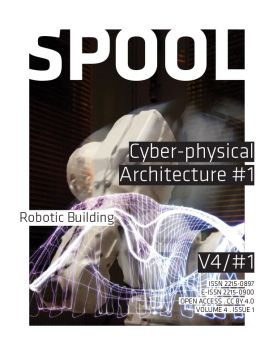JOURNALS
Vol 8 No 2
Cyber-physical Architecture #4
Advancements in Designing, Producing, and Operating Off-Earth Infrastructure
Issue's editors:
Dr.-Ing. Henriette Bier, TU Delft, NL
Dr. Angelo Cervone, TU Delft, NL
Dr. Advenit Makaya, ESA
Sending humans to the Moon and Mars in the near future requires appropriate infrastructure to support and subsequently sustain human activities. This includes infrastructure to shield from environmental conditions, generate energy, and facilitate mobility and communication. Construction of such infrastructure aims to use in-situ resources and reduce the use of supplies from Earth. The establishment and maintenance of the required infrastructure, equipment, and hardware involves the development of adequate manufacturing techniques, which can enable maximal use of the local resources. Those techniques can be based on processing of local materials into construction materials, extraction of useful elements from local materials or in combination with materials brought from Earth. The required manufacturing techniques address the range of needs for sustained human activities, from smaller scale manufactured items to large built structures. The design of such structures is associated with a number of space systems’ engineering challenges, ranging from the accurate definition of all resource budgets (mass, volume, power, data) to the design of the interfaces between all subsystems making use of these resources. The interplanetary spacecraft used to transport the required materials (and eventually, crew) from Earth to the final site would probably need to be designed ad-hoc for this specific application, given its peculiar mass and volume constraints, especially in case a reusable concept is adopted. Other engineering aspects involved in the design of the infrastructure systems include the selection of an appropriate power generation approach and the definition of the radiation environment in order to provide sufficient shielding to the habitats. This Spool CpA #4 issue investigates challenges of designing, engineering, constructing, operating, and maintaining off-Earth infrastructure.
https://doi.org/10.7480/spool.2021.2
Vol 7 No 3
Cyber-physical Architecture #3
Actuated and Performative Architecture: Emerging Forms of Human-Machine Interaction
Issue's editors:
Margherita Pillan, Politecnico di Milano
Henriette Bier, TU Delft
Keith Green, Cornell University
Milica Pavlovic, KU Leuven
This Spool [CpA] #3 issue poses and attempts to answer questions on the nature of this intimate human-machine bond, encouraging the discussion of its potentials also in terms of individual and social resilience. This issue of Spool, moreover, attempts to explore the design of bio-cyber-physical systems, which requires integration of natural, physical, and virtual architectures with digital systems and social organizations. In designing interactions between the (augmented) human and cyber-physical environments, the collection and use of personal data, the management of a multi-layered design approach, and the ethics of such design activity require attention from experts in architectural design, interaction and UX design, civil and architectural engineering, mechanical and electrical engineering, computer and information science, sociology, psychology, education, ethics, philosophy, media arts, and science and technology studies.
https://doi.org/10.7480/spool.2019.1
Vol 6 No 1
Cyber-physical Architecture #2
Apparatisation in & of Architecture
Issue's editors: Sang Lee, TU Delft and Henriette Bier, TU Delft
Apparatus and apparatisation, the focus of the Cyber-Physical Architecture (CpA) issue #2 of SPOOL, refer to an assemblage of various components, tools, and instruments that in combination produce an exponential surplus beyond the linear sum of parts. On the one hand, apparatus can be seen as a collective of means used to perform certain tasks in order to solve a range of problems. It can contain a series of tools and instruments and produce new rationalities that often translate into pervasive technology, such as, for instance, electricity and, today, Information and Communication Technology (ICT). On the other hand, apparatuses can be found in organisations and institutions that deal with various aspects of a society. For example, the police apparatus, of which rationalities are – rather than being embodied in physical technics – codified in written statutes. The apparatus in this sense is a collection of performative concepts that the subjective members of the apparatus execute in order to serve policies and plans.
In the context of the foregoing views of apparatus, architecture consists of both technics and concepts in design, construction, and use that have accumulated for generations. It has developed its canons through inherited practices (i.e. the conventions that have been established over time, or simply the way it has been done according to the tradition) that conflate the two in relation to the dominant forces (ideological, political, cultural, social, economic, etc.) of the time.
https://doi.org/10.7480/spool.2019.1
Vol 4 No 1
Cyber-physical Architecture #1
Robotic Building
Issue editor: Dr. Ir. Henriette Bier, TU Delft
While architecture and architectural production are increasingly incorporating aspects of non-human agency employing data, information, and knowledge contained within the (worldwide) network connecting electronic devices, the relevant question for the future is not whether robotic building will be implemented, but how robotic systems will be incorporated into building processes and physically built environments1 in order to serve and improve everyday life.
This 1st issue of SPOOL in 2007 aims to answer this question by critically reflecting on the achievements of the last decades in applications of robotics in architecture and furthermore outlining potential future developments and their societal implications. The focus is on robotic systems embedded in buildings and building processes implying that architecture is enabled to interact with its users and surroundings in real-time and corresponding design-to-production and -operation (D2P&O) chains are (in part or as whole) robotically driven. Such modes of production and operation involve agency of both humans and non-humans. Thus agency is not located in one or another but in the heterogeneous associations between them and authorship is neither human or non-human but collective, hybrid, and diffuse.
https://doi.org/10.7480/spool.2017.1




